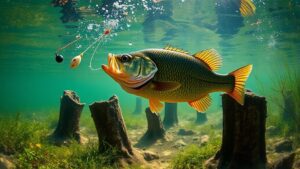To master the drop shot technique for bass fishing, you'll need to understand the core elements: proper gear selection, strategic leader length adjustment, and seasonal adaptations. Start with a medium-light spinning rod, 6-12lb fluorocarbon leader, and small soft plastic baits. Your leader length should match water conditions – shorter for stained water (4-6 inches) and longer for clear water (12+ inches). Pay attention to seasonal patterns, adjusting your presentation from aggressive in warm months to finesse in cold conditions. Focus on structure and cover, maintaining a natural bait presentation above the bottom. There's much more to explore in this highly effective fishing method.
Understanding Drop Shot Fundamentals
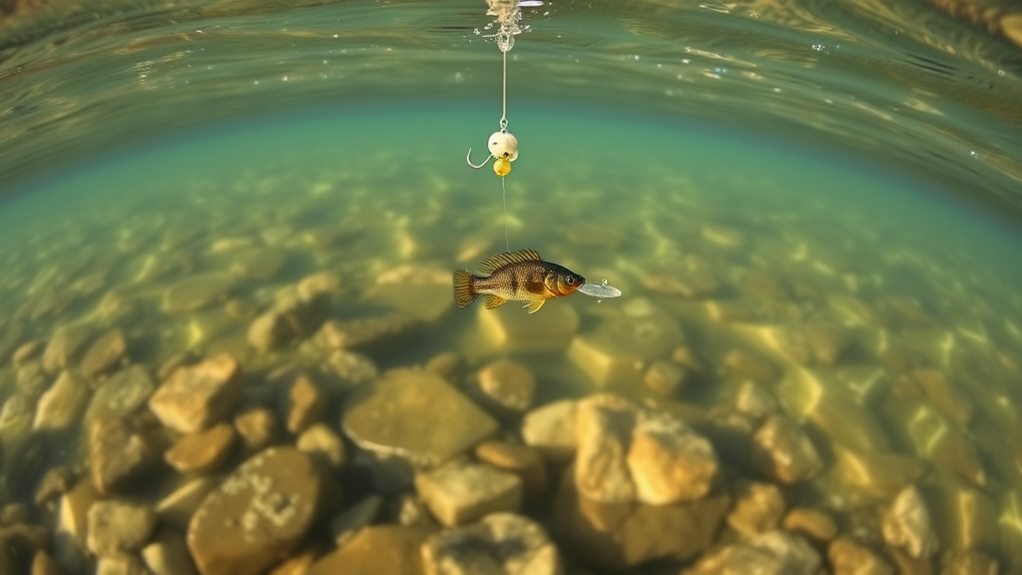
Drop shot fishing stands out as one of the most versatile and effective techniques for catching bass in any water condition. This finesse technique allows you to present your soft plastic bait in a natural, suspended manner that's irresistible to cautious fish.
Whether you're fishing from a boat or the bank, you'll find that the drop shot rig adapts perfectly to various water situations. Since bass are naturally ambush predators that prefer to strike from cover, this technique is particularly effective when fishing near structure.
To master this technique, you'll need to understand the basic setup. Start by tying your hook using a Palomar knot, positioning it about 14-16 inches above your weight. The leader length is essential – while 10-12 inches is standard, you can adjust this based on water clarity and cover.
Remember, the goal is to keep your bait hovering enticingly above the bottom.
When selecting your bait, focus on smaller soft plastics between 3-6 inches. Straight tail worms and swimbaits work exceptionally well, as they maintain a horizontal position that triggers strikes.
You'll catch bass more consistently once you've mastered this presentation, as it allows you to work your bait slowly and methodically through the strike zone.
Essential Gear Selection
Selecting the right gear for drop shot fishing can make the difference between landing trophy bass and losing them. As a bass angler, you'll want to start with a medium light spinning rod between 6'10" and 7'2", which provides the perfect blend of flexibility and control for fighting fish.
For your line setup, combine a 6-12lb fluorocarbon leader with 10-20lb braided mainline. This combo gives you the best of both worlds: the fluorocarbon delivers stealth and sensitivity, while the braid maximizes your casting distance and overall strength.
A smooth ATD drag system like those found in lightweight spinning reels will help you effectively play larger fish. You'll want to pair this with a 3000-3500 size reel that features backreeling capabilities and a smooth drag system.
Don't overlook your terminal tackle choices. Light wire hooks in sizes 4 to 1/0 are ideal for finesse presentations, and they'll help you avoid breaking off when fighting bigger bass.
As for weights, stick with tungsten weights in either cannon ball or cylinder shapes. While they're pricier than steel or brass options, tungsten's superior sensitivity makes it worth every penny – you'll feel every bump and bite along the bottom.
Leader Length and Water Clarity
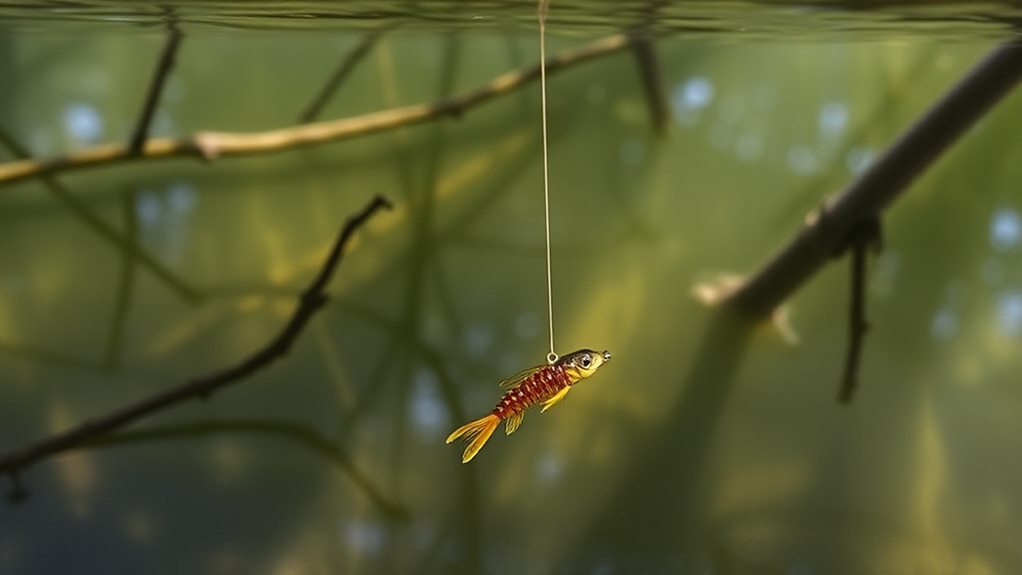
Water clarity plays a pivotal role in determining your drop shot leader length, with different conditions demanding specific adjustments.
When you're facing super-stained water, you'll want to opt for a short leader between 4 to 6 inches, keeping your bait close to the weight where fish can spot it more easily. This compact presentation is especially effective when visibility is severely limited.
In moderately stained conditions, you can't go wrong with the standard 10 to 12-inch leader length. This versatile setup provides enough separation between your weight and bait while maintaining an effective strike zone.
However, when you're dealing with crystal-clear water or high fishing pressure, it's time to lengthen your leader beyond 12 inches.
Pro Tip: Match Your Water
- Ultra-clear: 12+ inches
- Lightly stained: 10-12 inches
- Heavily stained: 4-6 inches
Remember to adjust your leader length based not just on water clarity but also the surrounding cover.
You'll find that paying attention to these details can greatly improve your catch rate, as fish respond differently to various presentations depending on their ability to see your bait.
Seasonal Drop Shot Strategies
Successful bass fishing demands strategic adjustments throughout the year, as seasonal changes dramatically affect fish behavior and feeding patterns. Your drop shot fishing success depends heavily on adapting your techniques to match these seasonal alterations, particularly when it comes to leader length.
During the chilly months when water temperatures hover in the high 30s, you'll want to stick with shorter leader lengths of 4-6 inches. These compact presentations are perfect for enticing those less-active winter bass.
As spring arrives and spawning conditions take hold, keep those leaders short to effectively target bass guarding their nests – they'll strike at anything that threatens their territory!
When summer temperatures soar above 90°F, switch to longer leader lengths exceeding 12 inches. This adjustment helps you catch some bass by presenting your bait more naturally in the warmer water.
During shifting seasons like spring and fall, mid-length leaders around 10-12 inches offer the versatility you need as fish adapt to changing conditions.
Weather Impact on Presentation
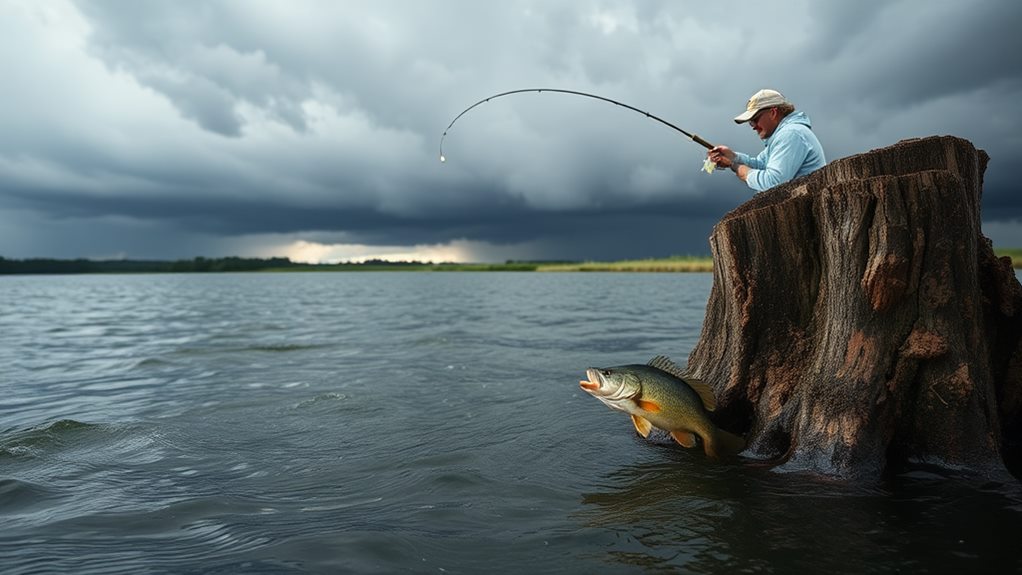
Beyond your seasonal leader adjustments, weather patterns play a major role in how you'll need to present your drop shot rig. Understanding how weather conditions influence bass feeding behavior will help you make significant adjustments to your presentation strategy, especially during challenging situations like cold water periods or clear water conditions.
Optimal water temperatures between 65-75°F typically produce the most consistent bass activity and feeding patterns.
On overcast days, you've got a prime opportunity to slow down your presentation and work deeper water, as bass tend to be more active and willing to venture from their cover.
When the wind picks up, you'll want to adjust your technique in the following ways:
- Increase your drop shot weight to maintain better control in choppy water
- Work your bait with slightly more aggressive movements to match the active conditions
- Focus on windward banks where baitfish are likely to concentrate
Keep an eye on your barometer, too. As pressure falls, you can typically be more aggressive with your presentations since bass are likely to be in a positive feeding mood.
Conversely, when pressure rises, you'll need to slow down and finesse your approach, making smaller, more subtle movements to entice those less-active fish.
Advanced Rigging Methods
Mastering advanced drop shot rigging techniques can dramatically improve your catch rates. When you're drop shotting, start by using approximately 2 feet of light line and thread your hook point-up for the most effective presentation.
During ideal feeding times, focus on adjusting your retrieval speed based on water temperature and fish behavior. This setup guarantees proper sink rate and bait movement, which are vital elements for enticing those finicky bass.
For best results, you'll want to focus on nose-hooking your soft plastic baits. This method allows your bait to swim naturally while maintaining a solid hook-up ratio.
When targeting suspended fish, remember to position your sinker at the line's end, keeping your bait hovering enticingly above the bottom. You might also try wacky rigging, which creates an irresistible wiggle that even pressured bass can't ignore.
Advanced rigging methods require attention to detail and regular maintenance.
Don't forget to:
- Check your line for wear
- Confirm hooks are sharp
- Verify knot integrity
- Monitor bait positioning
Cover and Structure Approaches
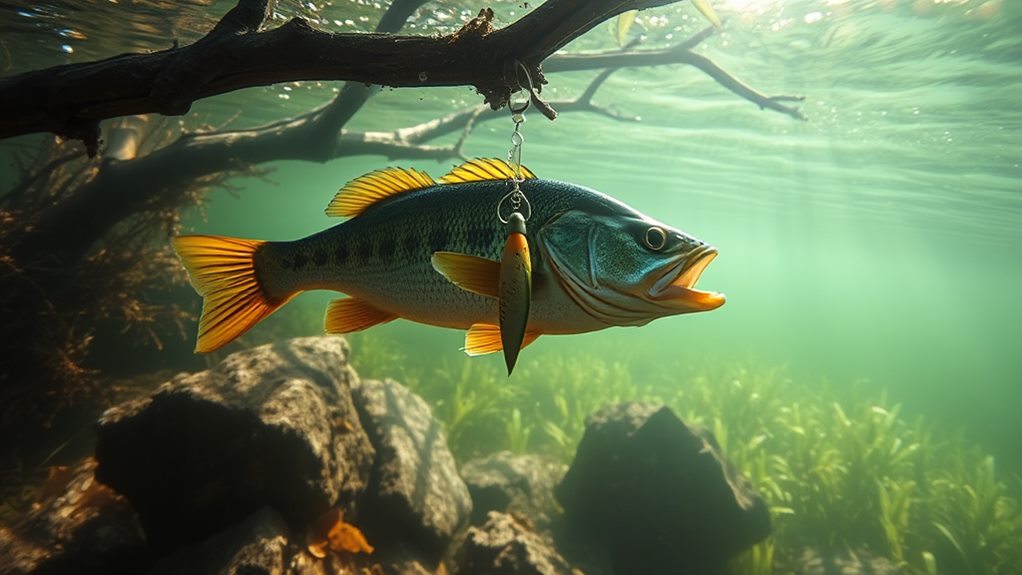
While proper rigging is fundamental, understanding how to approach different types of cover and structure will take your bass fishing to the next level. Your leader length selection directly impacts bait visibility and strike rates, so you'll need to adapt based on the cover you're fishing.
Here's how to match your drop shot leader length to different cover situations:
- Low cover areas (gravel, grass): Keep it short at 4-6 inches to maintain tight control and maximize bait visibility.
- Mid-range structure (submerged weeds, logs): Stick to 10-12 inches for best presentation and movement.
- High cover zones (boulders, cane piles): Go long with 12+ inches to keep your bait above obstacles.
When you're working structure edges, you'll want to pay special attention to your presentation. Bass love to ambush prey from these shifting areas, so positioning your bait near cover edges can trigger explosive strikes.
Bait Selection and Positioning
The art of bait selection can make or break your drop shot success. When targeting smallmouth bass, you'll want to focus on soft plastics between 3-6 inches that perfectly mimic their natural prey. In dirty water conditions, don't hesitate to switch to creature baits that create more vibration and visibility.
Your drop shot hooks should be positioned through the nose of your bait, allowing for maximum natural movement and better hook-up rates. Remember to maintain roughly 10-12 inches between your weight and bait, though you can adjust this based on water clarity and fish behavior.
| Condition | Bait Type | Position Height |
|---|---|---|
| Clear Water | Straight Tail Worm | 10-12 inches |
| Stained Water | Creature Bait | 8-10 inches |
| Deep Structure | Swimbait | 12-14 inches |
| Heavy Cover | Finesse Worm | 6-8 inches |
| Suspended Fish | Minnow Style | 14-16 inches |
Keep your retrieve slow and steady, paying close attention to how your bait responds to different structures. You'll find that proper positioning and bait selection become second nature with practice, leading to more consistent catches on the drop shot rig.
Power Versus Finesse Techniques

Successful bass fishing boils down to knowing when to punch hard and when to ease up. Power techniques shine when fish are aggressive, especially during warm months in open water. You'll want heavier tackle and faster retrieves to trigger reaction strikes.
However, finesse techniques like drop shotting become your secret weapon when conditions get tough.
When you're faced with clear water conditions or heavily pressured waters, you'll need to adapt your approach. Here's why finesse techniques often outperform power fishing:
- They present baits more naturally, reducing the chance of spooking wary fish
- They excel during cold fronts when fish become less active
- They're particularly effective when fish have seen too many traditional lures
Seasonal changes play an important role in choosing between power and finesse approaches. During summer's peak, you might start with power techniques in the morning when fish are actively feeding.
As the day progresses and fishing pressure increases, switching to drop shotting can help you continue catching bass that have become more selective. The key is staying flexible and reading the conditions to determine which approach will work best.
Reading Bass Behavioral Patterns
Mastering bass fishing requires a deep understanding of fish behavior across different conditions.
You'll notice that bass behavioral patterns shift dramatically with seasonal changes, water clarity, and temperature fluctuations. When you're working deep water areas, it's essential to adapt your vertical presentation based on these factors.
In stained waters, you'll want to keep your leader lengths shorter to maintain control and visibility of your bait. However, when you're fishing in crystal-clear conditions, longer leaders will help create a more natural presentation that won't spook wary bass.
During cold fronts, when bass become less aggressive, you might need to adjust your approach and shorten your leaders to provoke strikes.
Pay attention to the cover you're fishing, too. When targeting bass around low-lying structure like grass beds, shorter leaders work best. But if you're working around tall cover or boulders, you'll need longer leaders to get your bait where it needs to be.
Frequently Asked Questions
How Do You Catch Big Bass on a Drop Shot?
You'll catch big bass by using 3-6 inch soft plastics with a 12+ inch leader in clear water. Fish near cover, try dead sticking techniques, and adjust weight size based on depth and current.
What Is the Best Leader for a Drop Shot?
You'll want a 10-12 inch leader for standard conditions, but adjust to 4-6 inches in stained water and over 12 inches in clear water. Match your leader length to water clarity for best results.
What Is the Best Line for Drop Shot Fishing?
You'll want to use 6-12 pound fluorocarbon line for drop shot fishing. If you prefer, pair a 10-20 pound braided mainline with a fluorocarbon leader for better sensitivity and strength.
What Is the Best Bait for Largemouth Drop Shot?
You'll have the most success using 3-6 inch straight tail worms, 2.8-4 inch swimbaits, or creature baits. Nose-hook them for better action, and adjust your choice based on water conditions and season.

